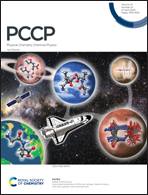Exploring the reaction mechanism of ethanol synthesis from acetic acid over a Ni2In(100) surface
Abstract
A low-cost and high-efficiency nickel-indium bimetallic catalyst is designed to improve the activity of acetic acid hydrogenation to ethanol, which can make full use of the overproduced acetic acid. In this work, density functional theory (DFT) calculations are carried out to explore the mechanism of ethanol synthesis from acetic acid on the Ni2In(100) surface and tailor the catalyst to acquire enhanced properties. The results show that the most feasible pathway is CH3COOH → CH3CO → CH3CHO → CH3CHOH → CH3CH2OH, and the rate-determining step is the hydrogenation of CH3CHOH* to CH3CH2OH, with an activation barrier of 1.20 eV and an endothermic energy of 0.15 eV. Compared with the Cu2In(100) surface, the Ni2In(100) surface converts the reaction pathway to the acetyl species direction, which shows great advantages for the following CH3CHO* formation. Furthermore, the effects of indium doping in the nickel catalyst on the side reaction is also discussed by comparing with the monometallic Ni(111) surface. The addition of indium turns out to cause a significant inhibition on the C–C bond breaking and is beneficial for promoting the acetic acid hydrogenation to ethanol. Electronic analysis proves that the role of In is to donate electrons, which can increase the electron density of Ni and enhance the catalytic activity.

- This article is part of the themed collection: 2020 PCCP HOT Articles


 Please wait while we load your content...
Please wait while we load your content...